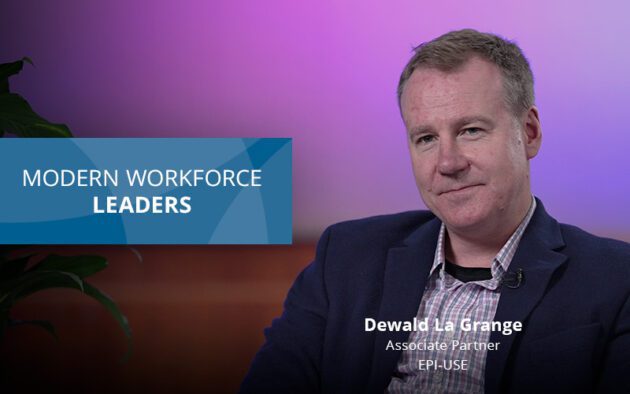The pandemic didn’t create the challenges facing modern workforce management — but it exposed the existing weaknesses. Namely that the global workforce is more diverse than ever, digitally native, and significantly more open to job change than past generations. So much so that many employees consider the technology provided by an organization a determining factor when choosing between multiple jobs, indicating that employee expectation is growing and employers need to step up if they want to attract and retain top talent.
Marc Gingras (SVP of Employee Experience Strategy at WorkForce Software) and Alexis Madsen (Visual Merchandising Lead for The Tile Shop) recently joined forces for a workshop at the GDS HR Insights Summit. They discussed how employers can utilize technology to meet employee needs, engage their deskless workers and ensure that all employees have a positive experience no matter where their work happens.
Here are some of the key takeaways from their presentation, “How HR Can Revolutionize Every Employee’s Experience with a Simple First Step.”
The Pandemic Has Accelerated Digital Transformation
The pandemic forced many desked workers to start working remotely, but for the frontline deskless workers who had to continue showing up to the workplace, new concerns arose such as screening processes, safety measures, and systems to ensure coverage in the event of sudden illness.
For both desked and deskless workers, changes that might have taken five or ten years were forced to happen within the span of a few months.
These changes made the necessity to balance corporate needs with the needs of employees more apparent. And while many shifted to working from home, other hourly workers left their jobs entirely in what has been dubbed “The Great Resignation.”
Deskless workers kept society running throughout the pandemic and are in short supply in many industries. So, it has never been more important to engage and retain these employees by focusing on creating a great employee experience.
Deskless Workers Have Different Needs Than Desked Workers, But Still Want Flexibility
Despite lots of talk about hybrid workplaces after the pandemic, deskless workers often don’t have the option to work from home. They still want to have flexibility, though.
One way to provide this is by giving them control over their schedule. Provide them with upcoming schedules as far in advance as possible. Let employees state their availability so that they aren’t given shifts at times that interfere with personal obligations. Check in with employees to make sure that they are able to arrange suitable child or family care options during times when they are scheduled to work.
Deskless workers may not be able to work from home, but there are concessions employers can make to let employees have their voices heard and their needs met.
Incorporating Communication into All Aspects of Work Improves Employee Experience
Employee communication should not be a siloed element of a company’s structure. Rather, communication should be interwoven throughout every aspect (and include every employee) of an organization.
For example, incorporating communication into task management means that employers are better able to explain tasks they are assigning, and employees are able to ask for clarification if they are unsure of expectations. Once a task has been assigned and completed, employers can communicate with employees to provide feedback.
Additionally, employers can incorporate communication into scheduling or time and attendance. Communication is key to scheduling, as employers should talk to employees to ensure that the shifts they are assigned are doable and employees should be communicating any availability issues that might arise with their managers.
Likewise for time and attendance, notifications about a particular employee working lots of overtime should prompt communication between employer and employee. The employer can reach out and check in with the employee — maybe they want the extra hours because they are saving up for a down payment on a house, but maybe they find working overtime stressful and it is interfering with family obligations. A simple conversation between employer and employee can bring these issues to light and resolve them.
Two-Way Communication Helps Corporate, Managers, and Employees Understand Each Other
The Tile Shop has seen first-hand the benefits of improved communication and the effect it has on employee experience since adopting WorkForce Experience.
As Alexis Madsen notes, since enabling their corporate and store employees with WorkForce Experience, she has a much better view into what is — or is not — happening in stores. Especially during the pandemic when travel was limited, it was impossible to have supervisors physically checking in at every location. With the ability to send direct, group, and company-wide messages, as well as photos and surveys, Madsen and her team are able to stay in touch and keep visual records of in-progress and completed tasks.
Two-way communication has also helped corporate, managers, and store employees better understand each other and their needs. The ability to have conversations in real time allows corporate to give instructions on product or campaign launches, then store employees can report back with what is working well or what needs to be improved. This sets clear expectations from higher-ups, but also allows frontline workers to be heard if there are unforeseen challenges or suggestions for improving work on the store floor.
“Now that we’ve incorporated WorkForce Experience, it really helps two-way communication,” Madsen said. “It gives our stores the sense that we’re also real people and we care about what they have to say.”
Overall, the Tile Shop has found that WorkForce Experience saves employees time when sharing information, makes collaboration easier, and fosters stronger relationships between employees around the globe.
Learn more about HR’s role in improving employee experience. To see first-hand how WorkForce Experience can improve your organization’s communication and employee experience, schedule a personalized demo.




